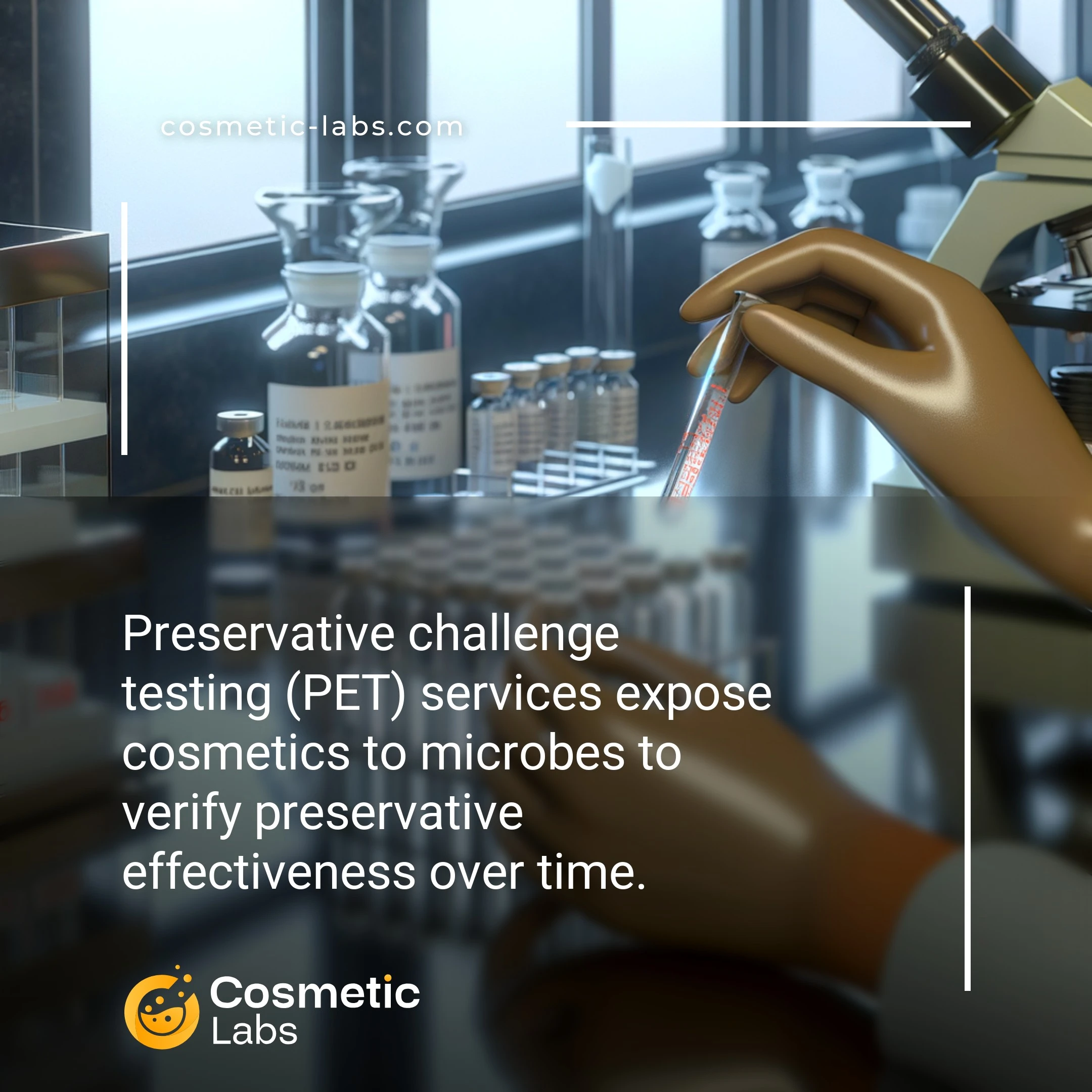Preservative Challenge Testing Services for Safe Cosmetic Products

What is Preservative challenge testing (PET)?
Preservative challenge testing (PET) is a microbiological test where labs deliberately contaminate your cosmetic formula with bacteria, yeast, and mold to verify your preservative system works. Testing follows ISO 11930 or USP 51 standards, with samples checked at 7, 14, and 28 days to ensure 99.9% microbial reduction meets regulatory requirements for product safety.
Why do you need this service?
Brands use PET services to validate shelf life claims before product launch, testing formulations against bacteria, yeast, and mold over 28 days. Our partner labs simulate real-world contamination scenarios, helping you determine if your preservative system protects products through repeated customer use and meets regulatory standards for global markets.
Who provides Preservative challenge testing (PET) services?
All cosmetic labs providing Preservative challenge testing (PET) services
There is no company providing these services at the moment.
Preservative Challenge Testing (PET) Services
Preservative challenge testing validates whether your cosmetic formula can resist microbial contamination throughout its shelf life. Labs on our platform test your products against bacteria, yeast, and mold to meet regulatory requirements and protect consumer safety.
What PET Testing Involves
Testing labs inoculate your product samples with specific microorganisms at controlled concentrations. They monitor microbial counts at set intervals—typically days 7, 14, 21, and 28.
Standard test organisms include:
- E. coli and P. aeruginosa (bacteria)
- S. aureus (gram-positive bacteria)
- C. albicans (yeast)
- A. brasiliensis (mold)
Labs follow ISO 11930 or USP 51 protocols, depending on your market requirements. Results show if your preservative system works effectively across different pH levels and temperatures.
Testing Timelines and Requirements
Most labs complete preservative efficacy testing within 28-35 days. You’ll need to provide 50-100g of finished product per test run.
Testing frequency depends on your formula:
- New formulations: test before launch
- Formula changes: retest when modifying preservatives or pH
- Annual validation: verify ongoing efficacy
Labs typically charge $800-1,500 per organism panel. Some offer package deals for multiple products or repeat testing. Connect with specialized testing labs on our platform to get quotes tailored to your product line.
Practical Applications of Preservative Challenge Testing in Cosmetic Development
Preservative challenge testing validates whether your formulation can resist microbial contamination throughout its intended shelf life under real-world conditions.
Water-Based Formulation Testing
Labs apply preservative challenge testing protocols to serums, lotions, and creams containing 60-90% water content. Testing involves inoculating products with specific microorganisms like Pseudomonas aeruginosa, Staphylococcus aureus, and Candida albicans at concentrations of 10⁵-10⁶ CFU/g.
Results determine if preservative systems maintain antimicrobial activity over 28 days. Labs track log reductions at days 7, 14, and 28 to verify compliance with ISO 11930 or USP 51 standards.
Multi-Phase Product Validation
Testing facilities evaluate complex emulsions, micellar waters, and biphasic makeup removers where preservatives must protect both aqueous and oil phases. Labs assess preservative partitioning between phases using specialized sampling techniques at each interface.
This testing reveals whether preservative concentrations remain effective in each phase after 6-month stability studies at 25°C and 40°C storage conditions.
| Product Type | Test Duration | Key Organisms Tested | Success Criteria |
|---|---|---|---|
| Face Creams | 28 days | P. aeruginosa, S. aureus, C. albicans | 3-log reduction by day 14 |
| Cleansing Gels | 28 days | E. coli, A. brasiliensis | 2-log reduction by day 14 |
| Eye Products | 28 days | P. aeruginosa, S. aureus | 3-log reduction by day 7 |
| Baby Products | 28 days | Full panel (5 organisms) | No increase from day 14-28 |
Partner with experienced testing laboratories on our platform to validate your preservative systems meet regulatory requirements for your target markets.
